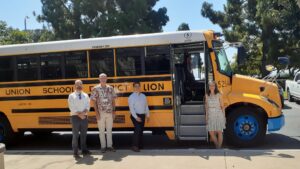July 19, 2022
Electric School Buses and Utilities: New Partnerships for Clean Air
Utilities are industry leaders who can help school districts electrify student transportation and improve public health
This week, ELPC’s Susan Mudd and I are in San Diego, CA, building partnerships for clean transportation. We brought an electric school bus to the National Association of Regulatory Utility Commissioners annual conference to illustrate the potential for ramping up this clean technology across the country.
Electric school buses are the nation’s largest form of mass transportation, carrying 25+ million kids each day. Electrifying this essential slice of the transportation sector will help protect our kids and communities from diesel pollution. And our electric utilities have a lot to gain from e-buses too! Electric school buses are essentially mobile battery and storage units that can provide electricity to the local distribution grids, to repower our communities when it is most needed. Building partnerships between school districts and utilities is a win-win for the bottom line and for the environment.
The Benefits of Electric School Buses
- Cleaner buses = healthier kids and communities – Currently, diesel buses make up over 90% of the U.S. fleet of school transportation, emitting a toxic mix of gases and particulate pollutions into our air every day. Children are especially susceptible to this pollution, since they breathe 50% more air per pound of body weight than adults and their lungs are still developing. Electric school buses produce no emissions, offering a clean, quiet transportation alternative to improve air quality and children’s health. All major school bus manufacturers now offer electric, for a total of 22 models, proven in all climates from Arizona to Alaska.
- Vehicle to Grid Resources – Electric school buses can also serve as energy resources for the whole community. When the bus is not driving, its large battery can store electricity and feed it back to the energy grid when needed. Buses charge at night when costs are low and wind energy is abundant, and they sit idle 75% of the year, including daytime hours during the school year and all summer when school is out of session. Energy demand is at its peak in the summer, when higher temperatures mean more air conditioners running. Instead of cranking up those dirty peaker coal plants to meet our energy needs, utilities could tap into vehicle batteries instead. In emergency situations, if the electric grid goes down, electric buses can provide mobile energy storage to repower community centers, health services, and more.
How Utilities can Help School Districts
- Overcoming barriers to entry – Electric school buses pay for themselves over time in lower operations and maintenance costs, but upfront costs are high. Utilities can create financing programs for buses and related infrastructure. Utilities can also use their knowledge of existing grid capacity to integrate charging, thereby reducing overall grid costs. In return, they gain valuable and reliable customers for years to come.
- Helping electric school bus programs succeed – Utilities are industry leaders who can help ease the transition to electrification. They can contact school districts where additional load is located who would make good candidates for electric bus pilot programs.
Utility leaders in action
- Seeing the benefits of Vehicle-to-Grid technology – Both National Grid in Massachusetts and Dominion Energy in Virginia have demonstrated proof of concept. Electric school buses delivered power back to the grid for over 50 hours during 30 transfer sessions in Massachusetts last summer, and Dominion is seeing results in Virginia this summer.
- Building strong partnerships with school districts – Nevada’s NV Energy ESB pilot program includes a $250,000 rebate per 100kWh bus and coverage of V2G charger cost for 40 buses with all buses participating in a V2G pilot program. Southern California Edison provides EV Readiness studies, fleet and site studies, grant writing assistance, and a depository of numerous resources. Virginia’s Dominion Energy proposed to achieve 1,000 ESBs in its service territory by 2025 and 100% ESBs by 2030 facilitated by offsetting the incremental costs of an ESB and including charging infrastructure.
Electric school buses are good for our kids and good for our communities, but school districts can’t transition alone. They need partners who have access to capital, who understand the long-term benefits of new technology, and who are experienced leaders in the energy industry. They need utilities. ELPC will continue to build bridges like this for cleaner air and a healthier future.
*A big thank you to the World Resources Institute (WRI), Lion Electric, and the Cajon Valley Union School District for helping to bring a bus to the conference for utility regulators to experience a clean, quiet ride in person.*


